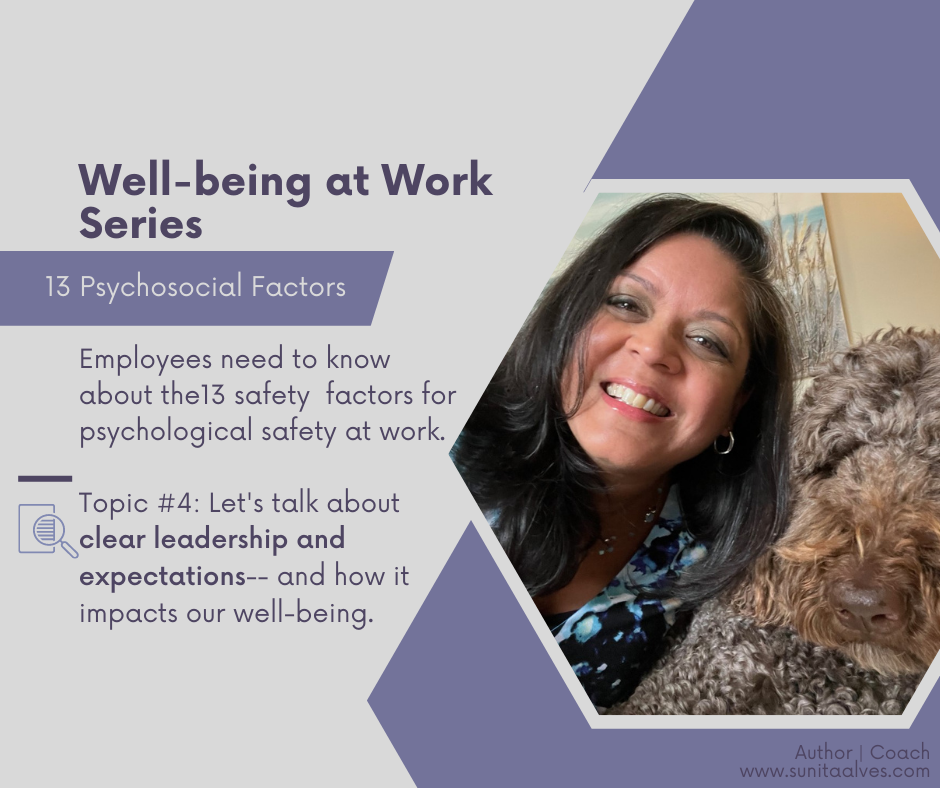Did you know clear leadership and expectations are one of 13 psychosocial factors identified in the National Standard for Psychological Health and Safety in the Workplace?
Find more peace and harmony in the workplace when psychological safety is present.
I started this series to talk about these 13 psychosocial factors.
The first, organizational culture, was discussed in this post on LinkedIn and blog.
The second, reward and recognition, was discussed in this LinkedIn article.
The third, workload management, was discussed in this LinkedIn article.
Today, let’s talk about #4, clear leadership and expectations.

What does it mean to have clear leadership and expectations? Different people in different roles would likely have different expectations.
But in terms of psychosocial risk, it’s defined this way by the Canadian Centre for Occupational Health and Safety , which might not be what you’d initially think:
- When present, it “helps employees know what they need to do.”
- When present, it “helps employees know how their work contributes to the organization and whether there are impending changes.”
- It’s a problem because “leaders who are more instrumental in their approach (such as focusing on producing outcomes with little attention paid to the big picture, the psychosocial dynamics within the organization, and the individual employees) are more likely to hear staff health complaints including general feelings of malaise, irritability, and nervousness.”
- It’s also a problem because “leaders who do not demonstrate visible concern for their own physical and psychological health set a negative example for their staff and can undermine the legitimacy of any organizational program, policy and/or service intended to support employees.”
So, in other words, psychological safety is supported when leaders communicate well with employees about their work and any upcoming or ad-hoc changes to the organization. And psychological safety is at risk when leaders are not walking the talk by working in a way that is contrary to the health and wellness standards of the organizations. We also need leaders that care about people and dynamics — not just outcomes.
It’s a reality of working life that sometimes people are put into positions of leadership when they lack the ability to communicate clearly or don’t have leadership and people skills. Sometimes people can seem like great communicators in an interview situation but are terrible when it comes to leading teams. Sometimes they are hired and promoted because of bias, favouritism, or the Peter principle, which states someone’s skills in their current job may not translate to their new role of leadership.
No matter the path a poor people leader takes to get to their position, they can cause unmeasurable stress once there. I don’t know how many conversations I’ve been in where we gathered as a team and tried to decipher ambiguous expectations or how a recent organizational change would impact us. I know my colleagues are disrupted from their work because of such worries. And people who already feel at risk at work – minority groups – may feel this stress even more.
Leaders should help reduce uncertainty or at least acknowledge it directly because people want to know a clear path to achieve their objectives so they have the best chance for raises and bonuses.
On another angle, people don’t want to miss the mark and be singled out as poor performers or put onto some lay-off list.
Lastly, people want to know if their job is in jeopardy and if they need to start looking for another role somewhere else.
All this uncertainty can add unnecessary stress when we’re already dealing with ambiguity in projects and the actual work we need to deliver.
VUCA is a military term to describe the chaos of the post-Cold War era, and it stands for “volatility, uncertainty, complexity, and ambiguity.” One way to reduce VUCA is leadership that leads to clarity and expectations that are S.M.A.R.T. (specific, measurable, achievable, realistic, and time-based).
Have you worked for a leader who communicates well on a timely basis — one who creates psychological safety? It’s great, isn’t it? And when it’s lacking, some people may feel quite unsafe. We just never know who may have trauma or other psychological conditions that make unclear leadership and expectations a serious concern to well-being.
What we measure, we can improve upon.
➡ I think we need to measure leaders by surveying the people they lead (or those that quit). Ask questions like: Does the leader create an environment where I feel supported? Do I have clarity on what is expected of me? Are changes to the workplace well-communicated?
➡ Coaching programs can help improve leaders’ ability to communicate and lead in a way that is aligned with the organizational values.
📢 This psychosocial factor is relatively easy to address and creates a positive impact.
⭐ Let’s think about how we constructively and effectively give and receive feedback on leadership styles.
💗 Psychosocial risks and psychological health and safety awareness can make a difference to employee well-being and the bottom line. Here is a short video that explains psychosocial risks, like the 13 factors in this series.
